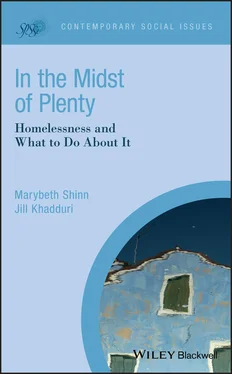This book argues that the United States and other wealthy, industrialized countries have the resources to end homelessness, if we make the policy choices to do so. Further, there is a good deal of evidence about what works—and what does not work—to prevent and end homelessness for different groups of people. The recent halving of homelessness among veterans (Henry et al., 2018) shows what can be done with will and resources. But to end homelessness it is important to understand more about it and where it comes from.
The book is organized around four questions: Who becomes homeless? Why do people become homeless? How do we end homelessness? How do we prevent it?
Chapter 1asks who becomes homeless in the United States, focusing on people living in homeless shelters, on the streets, and in other places not intended to be lived in, and on particular groups such as single adults, families, youth on their own, veterans, and people with chronic patterns of homelessness. The chapter also provides estimates of the number of people who experience homelessness each year and shows that, because homelessness is a transient experience, the number is much larger over a longer period of time such as five years or a lifetime.
Chapter 2asks why people become homeless. Some writers have assumed that the characteristics of homeless people are in themselves a sufficient explanation. This chapter challenges this assumption and examines causes in social policies and sociocultural attitudes, including patterns of social exclusion, as well as individual characteristics. International comparisons help us understand why rates of homelessness are higher in the United States than in most of Western Europe. The chapter argues that homelessness is essentially a housing problem, marshaling evidence on how the current crisis of homelessness came to be.
Chapter 3asks how to end homelessness for particular groups of people who experience it, focusing on programs with strong evidence of effectiveness for resolving homelessness and improving the lives of families with children and of individuals who have challenges such as severe and persistent mental illness. Chapter 4expands on this question, by examining comprehensive efforts to end homelessness. It introduces and assesses the components of the homeless services “system” that has grown up to address the problem and describes efforts to act strategically and with sufficient resources.
The final two chapters ask how to prevent homelessness. Chapter 5considers targeted prevention efforts directed at groups that are at special risk, and Chapter 6proposes broader policy changes to end the structural conditions that give rise to homelessness.
Some of the findings in each chapter may be surprising. For example, Chapter 1shows that the age at which people are at highest risk of entering a homeless shelter in the United States is infancy and that half of adults who experience sheltered homelessness over the course of a year do not suffer from severe mental illness or have any other type of disability.
Chapter 2suggests that the structural factors (e.g. income inequality, housing costs) that cause high rates of homelessness are rather different from the individual vulnerabilities (e.g. having a young child, mental illness) that affect which particular individual or family will succumb. Chapter 4notes that even service providers with long experience working with homeless people sometimes design ineffective policies and programs. And Chapter 5shows that prevention programs with more failures may also have more impact (because programs that rarely fail are offering services to people unlikely to become homeless to begin with).
Some may find the title of this book odd—many Americans do not feel that they are living “in the midst of plenty” and so have little to spare for those with even less. Or they may not feel that those with less are deserving of their aid. As we endeavor to show in Chapters 2and 6, the fact that too many Americans are struggling to get by is also a result of social choices such as recent changes in the tax code that provided most of the benefits to the wealthy.
Throughout this book, our basic theme is that homelessness stems from failures of social policy, in particular policies that fail to provide affordable housing for the many people for whom other social policies fail to provide adequate income either from jobs or (when they are unable to work) from income supports.
Does the United States have the resources to prevent homelessness? We think the answer is yes. To take just one example, America pays far more to subsidize housing for the wealthy than for the poor. Housing subsidies for rich people are written into the tax code, primarily in the form of the income tax deduction for mortgage interest. A series of proposals made over several decades would have capped those subsidies and distributed the savings to moderate income homeowners and renters (in the form of a tax credit rather than a deduction); they would also have been used to provide housing subsidies for people whose poverty‐level incomes mean that they cannot afford basic shelter and are at risk of falling into homelessness.
The final chapter of this book, Chapter 6, describes a number of policy options that would allow the United States to end homelessness. The United Nations included a right to housing in the Universal Declaration of Human rights 70 years ago (United Nations, 1948). Not all countries are wealthy enough to make that right a reality. In the United States, it is within our power to realize that right today.
Victor, a mason in his 50s, had run a family business repairing swimming pools and owned a large house and a car. After a heart attack and triple bypass surgery, he was prescribed the opioid oxycodone to manage the pain. He became addicted, then switched to heroin when the cost of oxycodone became $30 per pill. Estranged from his family as a result of his addiction, and having spent all his savings, Victor lost his home and his rights to visit his daughter as well. After a summer living in woods and parks, he found help at a homeless shelter and has been working on moving past his addiction and rebuilding his life.
Jasmine and her partner moved to North Carolina with their children. She got a job transfer with the same retailer she had been working for full‐time in New Jersey, but only a part‐time position was available. They lived with her partner's grandmother for some months, but then the grandmother had a stroke and had to move in with her daughter, who could not also house Jasmine's family. Jasmine and the children went to a hotel, which initially let her pay what she could. Then an emergency grant through her employer kicked in some rent. She took a second job at a fast food restaurant, at times leaving the children alone in the hotel. By chance, in the checkout line of the retail store where she works, she met the director of a program that helps homeless people move into rental housing.
William is a 57‐year‐old veteran with a non‐combat‐related disability, a back problem that occurred after he had left the service, and was working in the food industry. Without a job for 8 years, Social Security Disability payments were his only source of income, and he understood that they would no longer be available if he tried to work full‐time. William had lived in his own apartment for 5 or 6 years, but after drawing down his savings, he could no longer pay the rent. His aunt offered to help out but only if he found something less expensive. William didn't want to leave his home but eventually moved out and became homeless, sometimes staying in a family member's attic. His sister suggested that, because he was a veteran, he might try the Veterans Administration (VA) for help. He did that and started to receive medical care through the VA and also short‐term rental assistance.
Читать дальше












